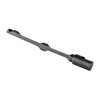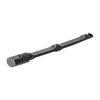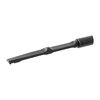Achieving an optimal claw to breech face dimension is a key ingredient in getting consistent extraction and ejection from your 1911. Once you've set a pistol up for optimum claw to breech spacing and see what it does for the consistency of ejection, this will be a service you'll offer to every customer. There are various places in the design and manufacture of a 1911 pistol where "float" occurs in dimensions and tolerances. One of the places that this shows up and causes problems is with the distance between the extractor claw and the breech face. Easily measured with common feeler gauges, when your gap exceeds .070" - .075", the front side of the extractor claw will start hitting the "rebate" of the cartridge case, i.e. the angled cut just forward of the case rim. If you have a headspace dimension on the tight side, the case will push back as the round goes into battery and cause the extractor tip to cam outwards. The pistol will likely throw brass all over the place, including back into the shooters face! Some folks try to alleviate this by filing away some of the extractor nose to reduce contact with the case. A better way to tune this problem out of the gun is to "move" the extractor claw back to an optimum spacing from the breech face. To do this, the slot in the rear of the extractor has to be relocated somehow. Different methods of filling the slot have been used such as TIG welding, silver soldering, peening. They work to varying degrees, but are all a bit more aggressive than need be. Harrison Design is now offering extractors with no slot cut for the firing pin stop. By taking some simple measurements, making some simple calculations and locating & machining the slot, a gunsmith equipped with a mill and my fixture can accurately cut the slot in a location that will give optimum spacing of the claw from the breechface. Harrison Design has found this to make a big improvement in the consistency in where a pistol throws it's brass. Harrison Design is initially offering the "No-Slot Extractor" in .45 ACP, blued, Series '70 configuration. Others will be offered as sales dictate.














